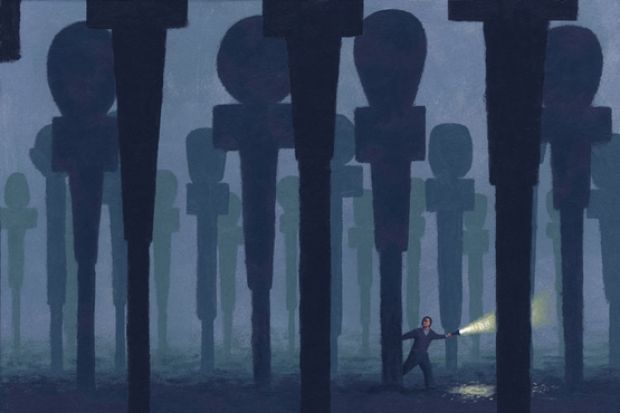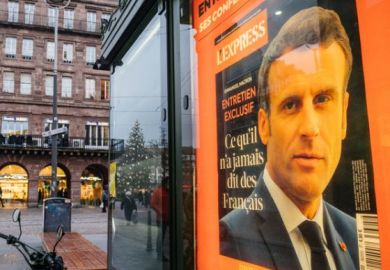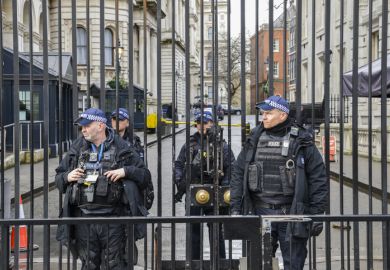Source: James Fryer
No university wants to lose Richard III. Finding secure storage for the remains of what could prove to be a king takes more effort than one might think
The discovery of what eventually turned out to be Richard III’s bones under a car park in Leicester unexpectedly threw me and my colleagues involved in the research into the global media spotlight.
It has been both exciting and daunting to face a room filled with hundreds of journalists, to handle newspaper, television and radio interviews, and to answer questions from members of the public in online Q&A sessions. When I became head of the University of Leicester’s School of Archaeology and Ancient History just six months ago, it was hardly something I could have anticipated. At the start of the excavation of Grey Friars church, I and Richard Buckley, the co-director of our professional archaeological unit, expected to find evidence of a previously unknown medieval church - exciting enough in its own right. But as the significance of what we had unearthed gradually emerged over the five months of our investigation, we had to confront a range of challenges outside our immediate expertise.
One of the greatest has been balancing the demands of exceptional but legitimate public interest with our priority: conducting an impeccable, multifaceted research investigation of the Grey Friars finds as a whole.
The huge interest from the public and the media attention raised major security and confidentiality issues. Academics can be wary of the press, and we were acutely aware of the danger of “publication by news media”. Overenthusiastic or insensitive journalists could have detracted from proper investigation by taking dissemination out of our hands. Revealing individual results out of context or releasing preliminary findings that had not been checked against other evidence could have muddied the waters and led to the printing of misinformation that is difficult to eradicate. So we had to find appropriate ways to present the research in the public domain as accurately and as accessibly as possible at each stage while maintaining the scholarly integrity of the investigation. This meant producing press releases and drafting journal articles in tandem.
Finds that attract intense public scrutiny raise a variety of unanticipated logistical, security and diplomatic issues that can, if handled badly, turn into media disasters. No university wants to be responsible for the loss of Richard III. Finding secure storage for the remains of what could prove to be a king takes more time and effort than one might think.
And the finds came with a whole package of ethical and political sensitivities. Archaeologists in general, and human osteologists in particular, understand the ethical issues surrounding the treatment of human remains (such as religious practices associated with burial), and there are national and international guidelines. But few journalists seemed to realise this: we repeatedly had to make clear that we treat human remains with dignity. Meanwhile, various individuals and communities in England came forward to claim “Richard” for reinterment - before we had even ascertained the identity of the skeleton.
Perhaps most difficult has been the balancing act with colleagues. The media attention compelled us to work in secrecy. This does not come naturally to us. We wanted to and needed to discuss our results with others and to confer with specialists in other disciplines. Accomplishing this tactfully and discreetly, without making some feel excluded, has been tough. We also had to communicate with our project partners and other interested parties (such as the amateur interest group, the Richard III Society) whose concerns had to be accommodated sensitively without compromising confidentiality, academic integrity or security.
All these issues can put academics unused to media attention under enormous pressure. At last week’s press conference, we faced 140 different media agencies, and at times it felt like being in front of a firing squad. Even with support from a good communications department, individuals must face big organisational challenges and serious work overload. Inevitably, we all ended up doing hundreds of interviews and all the rest on top of the “day job”.
But I have enjoyed my 15 minutes of fame and the opportunity to speak with so many interested people from every continent. With few exceptions, we feel that the coverage has been overwhelmingly positive. I hope that our work will raise the profile of the study of the past as a whole and show why it is important and worth pursuing and funding. I also want to use the project as a launch pad for developments that will benefit students, colleagues, my institution and the wider community.
Inevitably, there have been some difficult moments. Australian interviews are at inconvenient times (I’m not keen on phone interviews in the shower). And the views of journalists, film crews and members of the public about what is significant or appropriate, or what the evidence does or does not say, can be very different from those of professional academics. More than anything else, though, it has been a huge amount of fun.
Register to continue
Why register?
- Registration is free and only takes a moment
- Once registered, you can read 3 articles a month
- Sign up for our newsletter
Subscribe
Or subscribe for unlimited access to:
- Unlimited access to news, views, insights & reviews
- Digital editions
- Digital access to THE’s university and college rankings analysis
Already registered or a current subscriber? Login




